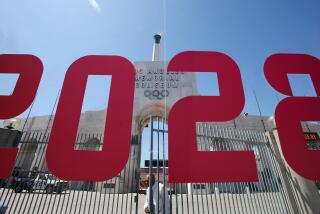‘Bus of Tomorrow’ Is Running Late, Transit Expert Says
- Share via
SAN FRANCISCO — Development of the “bus of tomorrow” is being hung up by high costs and instability in the public transit industry, the American Public Transit Assn. has been told.
As a result of those problems, transit buses in the 1990s may not be much different from those in use today, according to Scott A. Mintier, executive vice president of Transportation Manufacturing Corp., based in Roswell, N.M.
The landmark Advanced Design Bus program initiated by federal transportation officials in the late 1970s led to improved safety, comfort and performance features. But Mintier said private companies have been slower to build futuristic buses more recently because of the economic risks inherent in trying to determine a single bus design that will meet cities’ different needs.
“It is this process that leads us to believe that there will not be an all-new ADB (advance design bus) in the foreseeable future, at least not one that will be successful,” he told about 100 people at the panel on bus development.
“We believe that the transit bus of tomorrow will be an evolutionary improvement of today’s vehicle, not a revolutionary advancement of the state of the art.”
About 11,000 people from the United States and 50 other countries attended the transit association’s recent annual meeting and international public transit exposition at the Moscone Convention Center.
The Urban Mass Transportation Administration encouraged manufacturers beginning nearly a decade ago to build better buses, offering as an incentive funding from its Advanced Design Bus program.
Buses built under the guidelines of the program are in use in New York, Pittsburgh, Seattle and numerous other major cities, according to agency spokesman Buddy Bynum.
The next generation of buses is envisioned as having more economical engines, more comfortable seating and a better aerodynamic design, including a curvier shape and tapered edges to reduce wind resistance.
But while a slightly more modernistic-looking bus prototype built by Mintier’s company was on display at the convention, the transportation executive emphasized, “We don’t know what the future ADB is going to look like.”
Noting that the original development cost for Advanced Design Bus models was about $100 million, he said companies can’t justify that expense now because neither demand nor sale prices are high enough. He said some companies have gone out of business because of their innovative efforts.
“As to who is going to pay for this new bus of tomorrow, I submit to you that no one is trying to be first in line,” Mintier said. “The transit authorities are mired in a low-bid environment, which does not promote significant innovation and the manufacturers must contend with prices that remain at 1980 levels.”
Transportation Manufacturing Corp. has been working on various designs but is reluctant to build one because of the high costs and risks in research and development.
“Who is to blame for this instability in our industry?” Mintier asked. “Is it the manufacturer, the transit authorities, the government, or is it innovation itself?
“Do any of us have the answer? Probably not, but to some extent it is all of the above.”
More to Read
Sign up for Essential California
The most important California stories and recommendations in your inbox every morning.
You may occasionally receive promotional content from the Los Angeles Times.













